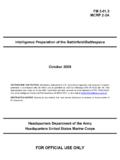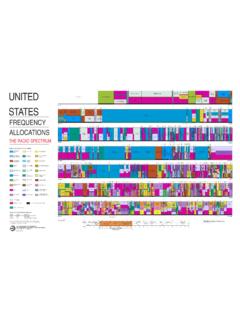Transcription of Infantry Rifle Platoon and Squad - Seton Hall University
1 FM 7-8 Table of ContentsRDLH omepageDocumentInformationDownloadInstru ctions*FM 7-8 FIELD MANUALNO. 7-8 HEADQUARTERSDEPARTMENT OF THE ARMYW ashington, DC, 22 April 1992FM 7-8 Infantry Rifle Platoon AND Army Infantry School Statement NATIONAL POLICY CONCERNING ANTIPERSONNEL LAND MINES Table of ContentsCHANGE 1 (1 of 10) [1/9/2002 9:34:30 AM]FM 7-8 Table of ContentsChapter 1 - DOCTRINES ection I - Fundamentals1-1. Mission1-2. Combat Power1-3. Leader Skills1-4. Soldier Skills1-5. TrainingSection II - Platoon Operations1-6. Movement1-7. Offense1-8. Defense1-9. SecurityChapter 2 - OPERATIONSS ection I - Command and Control2-1.
2 Mission Tactics2-2. Troop-Leading Procedure2-3. Operation Order FormatSection II - Security2-4. Security During (2 of 10) [1/9/2002 9:34:30 AM]FM 7-8 Table of Contents2-5. Security in the Offense2-6. Security in the DefenseSection III - Movement2-7. Fire Team Formations2-8. Squad Formations2-9. Platoon Formations2-10. Movement Techniques2-11. Actions at Danger AreasSection IV - Offense2-12. Movement to Contact2-13. Deliberate Attack2-14. Attacks During Limited VisibilitySection V - Defense2-15. Conduct of the Defense2-16. Security2-17. Command Post and Communications2-18.
3 Weapons Emplacement2-19. Range Cards2-20. Types of (3 of 10) [1/9/2002 9:34:30 AM]FM 7-8 Table of Contents2-21. Squad Positions2-22. Platoon Positions2-23. Sector Sketches2-24. Fire Control Measures2-25. Priority of Work2-26. Coordination2-27. Fighting PositionsSection VI - Other Operations2-28. Withdrawal2-29. Delay2-30. Retirement2-31. Linkup2-32. Stay-Behind Operations2-33. Relief in PlaceSection VII - Fire Support2-32. Offensive Fire Support Planning2-33. Defensive Fire Support Planning2-34. Techniques of Indirect Fire ControlSection VIII - Combat Service (4 of 10) [1/9/2002 9:34:30 AM]FM 7-8 Table of Contents2-35.
4 Planning of Combat Service Support2-36. Resupply Operations2-37. Resupply Techniques2-38. Aerial Resupply2-39. Maintenance2-40. Transportation2-41. Soldier's Load2-42. Personnel Service Support2-43. Health Services SupportSection IX - Armored Vehicle Support2-44. Combined Operations With Armored Vehicles2-45. Considerations2-46. Communicating With Tanks2-47. Infantry Riding on Armored VehiclesSection X - Obstacles2-48. Employing Obstacles2-49. Types of Obstacles 22-50. Enemy Obstacles2-51. Breaching and Clearing (5 of 10) [1/9/2002 9:34:30 AM]FM 7-8 Table of ContentsSection XI - Nuclear, Biological, and Chemical Operations2-52.
5 Operating in a Nuclear Environment2-53. Operating in a Chemical and Biological EnvironmentSection XII - Observation Posts2-54. Considerations2-55. Actions at the Observation Post2-56. Squad -Sized Observation Post2-57. Visual Terrain SearchSection XIII - Techniques of Fire2-58. Fire Distribution2-59. Fire Control2-60. Methods of Engagement With LAW and AT4 Section XIV - Limited Visibility Techniques2-61. Night Vision2-62. Dark Adaptation2-63. Planning the Use of Night Vision/Sensor Assets2-64. Night Operation Tips and TechniquesChapter 3 - PATROLLINGS ection I - Planning (6 of 10) [1/9/2002 9:34:30 AM]FM 7-8 Table of Contents3-1.
6 Organization 33-2. Initial Planning and Coordination3-3. Completion of the Plan3-4. Departure From Friendly Lines3-5. Rally Points3-6. Leader's Reconnaissance of the Objective3-7. Reentry of Friendly Lines3-8. DebriefingSection II - Reconnaissance Patrol3-9. Organization3-10. Tasks to Subordinate Units3-11. Area Reconnaissance3-12. Zone Reconnaissance3-13. Route ReconnaissanceSection III - Combat Patrol3-14. Organization3-15. Tasks to Subordinate Units3-16. Leader's Reconnaissance of the Objective3-17. (7 of 10) [1/9/2002 9:34:30 AM]FM 7-8 Table of Contents3-18. Hasty Ambush3-19.
7 Deliberate Ambush3-20. Point Ambush3-21. Area Ambush3-22. Antiarmor Ambush3-23. RaidSection IV - Tracking Patrol3-24. Considerations3-25. Organization3-26. Tasks to Subordinates3-27. Training3-28. Intelligence3-29. Trail SignsSection V - Patrol Bases3-30. Site Selection3-31. Planning Considerations3-32. Patrol Base Occupation3-33. Patrol Base ActivitiesChapter 4 - BATTLE (8 of 10) [1/9/2002 9:34:30 AM]FM 7-8 Table of Contents4-1. Definition4-3. FormatBattle Drill 1. Platoon AttackBattle Drill 1A. Squad AttackBattle Drill 2. React to ContactBattle Drill 3. Break ContactBattle Drill 4.
8 React to AmbushBattle Drill 5. Knock Out BunkersBattle Drill 6. Enter Building/Clear RoomBattle Drill 7. Enter/Clear a TrenchBattle Drill 8. Conduct Initial Breach of a Mined Wire ObstacleChapter 5 - Infantry Platoon STANDING OPERATING PROCEDURE* Chapter 6 - URBAN OPERATIONSA ppendix A - ORGANIZATIONA ppendix B - Infantry Platoon REFERENCE GUIDEG lossaryReferencesDA Form 5517- (9 of 10) [1/9/2002 9:34:30 AM]FM 7-8 Table of ContentsAuthorization LetterDISTRIBUTION RESTRICTION -- Approved for public release; distribution is unlimited.*This publication supersedes FM 7-8, 31 December 1980; FM 7-70, 10 September 1986.
9 (10 of 10) [1/9/2002 9:34:30 AM]US NATIONAL POLICYRDLH omepageTable ofContentsDocumentInformationDownloadIns tructionsUS NATIONAL POLICYONANTIPERSONNEL LAND MINESOn 16 May 96, The President of the United States announced a national policy that eliminates or restricts the use of antipersonnel land mines, beginning with those that do not self-destruct but eventually including all types. This policy is in effect now. It applies to all Infantry units either engaged in, or training for, operations US policy allows the use of non-self-destructing antipersonnel land mines only along internationally recognized national borders or in established demilitarized zones, specifically for the defense of Korea.
10 Such mines must be within an area having a clearly marked perimeter. They must be monitored by military personnel and protected by adequate means to ensure the exclusion of national policy also forbids US forces from using standard or improvised explosive devices as booby for units in Korea or units going there for a designated exercise, this policy specifically forbids all training on or actual employment of inert M14 and M16 antipersonnel land mines either at the unit's home station or at a Combat Training Center except in the context of countermine or de-mining training.








